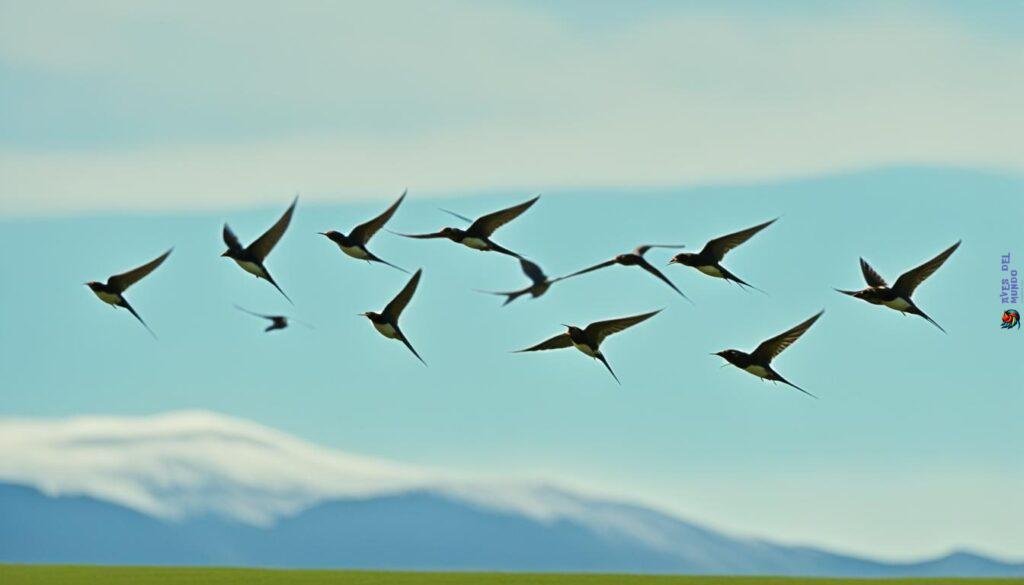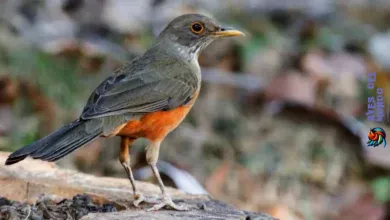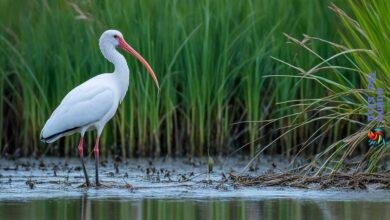Did you know that swallows migrate approximately 6,000 miles between their breeding grounds in the UK and South Africa? This astounding journey takes them through Europe and across the Sahara desert, facing potential hazards and challenges along the way. Swallows are not only fascinating for their migration, but they also exhibit unique nesting behavior and have cultural symbolism that spans across societies and cultures. In this article, we will explore the migration patterns, nesting behavior, conservation efforts, and symbolism surrounding these remarkable birds. Let’s delve into the world of swallows and discover the wonders they hold.
The Swallows Migration Routes
Swallows undertake an impressive migration journey between their breeding grounds in the UK and their wintering grounds in South Africa. They follow specific migration routes that take them south through Europe and across the Sahara desert. The migration journey covers approximately 6,000 miles and requires them to fly around 200 miles a day, generally at speeds of about 20mph, with the maximum recorded flight speed being 35mph. They face potential challenges along the way, such as starvation, exhaustion, and extreme weather conditions. The migration typically begins in September and October, as their food source starts to run out in the UK in the autumn. Swallow populations can fluctuate from year to year due to these migration challenges and other factors.
During their migration, swallows demonstrate remarkable navigational skills, following a specific route to ensure their successful journey. They utilize various natural cues, including the position of the sun, the Earth’s magnetic field, and landmarks along the way, to stay on course. Swallows are known for their precision in returning to the same breeding and wintering grounds year after year, which highlights the importance of their migration routes in their survival.
| Migration Stages | Time Frame |
|---|---|
| Departure from UK | September-October |
| Flight through Europe | October-November |
| Crossing the Sahara Desert | November-December |
| Arrival in South Africa | December-January |
This migration route ensures that swallows can find abundant food and favorable breeding conditions in South Africa during the UK winter. The return migration takes place in the spring, as they make their way back to their breeding grounds in the UK to take advantage of the summer abundance of insects for feeding and breeding.
«Swallows follow a precise route during their migration, relying on natural cues and landmarks to navigate their way between the UK and South Africa.»
– Bird Migration Expert
The swallows’ migration routes are crucial to their survival and are influenced by a combination of innate biological programming and environmental conditions. Understanding and protecting these routes is essential for the conservation of these remarkable birds and their extraordinary migratory behavior.
Swallow Nesting Behavior
Swallows exhibit unique nesting behavior compared to other songbirds. While most songbirds use a nest for only a single breeding season, swallows show a high level of nest-faithfulness. Many pairs of swallows return to the same nests year after year, with approximately 44% of pairs reoccupying the same nest. This is remarkable considering the length of their migration journey from their wintering grounds in South Africa.
Swallows typically nest during the summer months, with peak nesting occurring in June. They have multiple broods during the breeding season, and most baby swallows are born in June. Swallow parents are actively involved in caring for their young, ensuring their survival and growth.
«Swallows show a high level of nest-faithfulness, with approximately 44% of pairs reoccupying the same nest year after year.»
This behavior highlights the strong bond between the swallows and their chosen nesting sites. It allows them to benefit from established nests, saving time and energy that would otherwise be spent searching for new nesting sites each year. The nest-faithfulness of swallows is believed to be influenced by a variety of factors, including the availability of suitable nesting sites and the successful raising of previous broods.
By reusing their nests, swallows also contribute to the conservation of their habitats, as they help maintain the structural integrity of the nests and reduce the impact on natural resources.
The image above captures the essence of a swallow nesting in its familiar environment, exemplifying the nest-faithfulness behavior displayed by these remarkable birds.
Swallow Migration Timeline
The annual cycle of swallow migration follows a well-defined timeline throughout the year. Understanding this timeline allows us to appreciate the incredible journey these birds undertake and the challenges they face along the way.
- In January, most barn swallows can be found in South America, where they are finishing up their molts in preparation for migration.
- By February, the first breeding barn swallows start to reach southern California and Texas, while the majority of American barn swallows are still in South America.
- Migration peaks in central states during April, with swallows crossing the United States and reaching their breeding grounds in northern states and provinces by May.
- June is the peak nesting period for swallows, with most baby swallows being born during this month. Swallow parents are actively involved in caring for their young, ensuring their survival and growth.
- In July, as the swallows finish nesting, they start gathering in migratory groups. The young swallows stay with their parents during migration, learning the routes and behaviors from their experienced parents.
- August marks the peak of fall migration, with swallows passing through southern states on their journey south.
- By September, migration is in full swing, with swallows heading towards their wintering grounds in South America.
- By October, most swallows have arrived in South America and are preparing for their molt, which peaks in November and December. During this time, swallows shed and replace their feathers, ensuring they are in top condition for the next breeding season.
The swallow migration timeline highlights the remarkable annual cycle these birds go through, from nesting and raising their young to embarking on the long journey to their wintering grounds. The challenges they overcome and the precision of their navigation instincts are awe-inspiring.
Noteworthy Quote
«Migration is a testament to the resilience and determination of swallows as they navigate countless obstacles to reach their destination.» – Birdwatcher

As you can see, the swallow migration timeline is a carefully orchestrated process that ensures the survival and continuation of these incredible birds’ species. From their wintering grounds in South America to their breeding grounds in North America, swallows captivate us with their yearly journey. The next section will delve into the conservation efforts aimed at protecting these remarkable birds and their habitats.
Swallow Conservation and Symbolism
Swallows hold a special place in both bird conservation efforts and symbolism. These iconic birds are not only admired for their remarkable migration patterns and acrobatic flight but also for their cultural significance and symbolic meanings.
Swallow Conservation Efforts
Bird conservation organizations are actively involved in protecting swallow populations and their habitats. By preserving swallow habitats and promoting awareness about their ecological importance, these efforts ensure the well-being and survival of these birds.
Swallows play a crucial role in controlling insect populations and are indicators of a healthy environment. By feeding on flying insects, they contribute to the balance of ecosystems, making them an invaluable asset to our natural world.
Symbolism of Swallows
Swallows have held symbolic meanings in various cultures throughout history. They are often associated with positive qualities such as love, loyalty, resilience, and freedom.
«The swallow to the nest, the heart to the home.» – Chinese Proverb
In ancient times, swallows were believed to bring good fortune and happiness. Their arrival in certain regions symbolized the changing of seasons, the return of warmth, and the start of new beginnings.
Today, swallows continue to captivate our imaginations and are popular subjects in art, literature, and cultural traditions worldwide. Their symbolism represents the enduring human desire for hope, renewal, and the pursuit of freedom.
Swallow Symbolism in Different Cultures
Swallows hold significant symbolic meanings in various cultures:
- In Chinese culture, swallows symbolize loyalty and the reunion of loved ones.
- In Native American cultures, swallows represent the power of endurance, determination, and the connection to the spiritual world.
- In European folklore, swallows were thought to protect against evil spirits and bring happiness and good fortune.
The diverse symbolism associated with swallows reflects their universal appeal and the profound impact they have had on human cultures throughout history.
Identifying Swallows
Swallows can be easily identified by their distinct characteristics. They have dark metallic blue plumage, a chestnut forehead and chin, and a noticeably longer forked tail compared to swifts and house martins. Up-close, their features and plumage are more apparent, but even when they are silhouettes in the sky, their longer forked tail can help distinguish them from other similar birds. Swallows also feed closer to the ground compared to swifts and house martins, which can be observed during their foraging flights. Taking note of these characteristics and behaviors can help bird enthusiasts and observers identify swallows in their natural habitats.
To summarize:
- Distinct characteristics include dark metallic blue plumage, a chestnut forehead and chin, and a longer forked tail compared to swifts and house martins.
- Observing their foraging flights can help identify their closer proximity to the ground.
The Swallows Migration in the Americas
Swallows in the Americas follow a similar migration pattern as their counterparts in the UK. They are long-distance migrants, with their migration primarily occurring from North America to their wintering grounds in South America. Their migration routes differ based on their specific populations.
Eastern populations of swallows in the Americas are believed to migrate along the Atlantic coast, traveling through places like Florida and Central America to reach their wintering grounds in South America. On the other hand, western populations likely travel along the eastern Rockies and the Pacific coast.
Tree swallows, a type of swallow, begin their migration south in July and August. During their journey, they fly during the day and roost in large flocks at night, often gathering in large numbers.
Understanding the specific migration patterns of swallows in the Americas is crucial for our knowledge of their population dynamics and aids in conservation efforts. By tracking their movements, researchers can better protect their habitats and implement conservation strategies to ensure the survival and well-being of these incredible migratory birds.
Swallow Migration Routes in the Americas
| Swallow Population | Migration Route |
|---|---|
| Eastern Populations | Atlantic coast (Florida, Central America) to South America |
| Western Populations | Eastern Rockies and Pacific coast to South America |
| Tree Swallows | Across North America, gather in large flocks before heading to South America |
The image above depicts swallows in flight, symbolizing their remarkable migratory journeys across the Americas.
The Symbolism of Swallows in Nature and Culture
Swallows hold a rich symbolism in both nature and culture. These graceful birds are often associated with positive and uplifting qualities, embodying concepts such as love, loyalty, good fortune, and freedom. Across many cultures and regions, swallows are considered harbingers of spring, symbolizing renewal and transformation. Their arrival in certain areas signifies the changing of seasons, bringing warmth and new beginnings.
In various forms of artistic expression, swallows have left an indelible mark. Swallow tattoos, for example, have become popular for their symbolic meanings. They represent the journey of life, the unwavering loyalty to loved ones, and the pursuit of freedom. The image of a swallow permanently inked on one’s skin serves as a reminder of personal growth, resilience, and the ability to overcome challenges.
Throughout history, swallows have captivated the human imagination and inspired awe. Their remarkable migration patterns, unique nesting behaviors, and acrobatic flight have been celebrated in art, literature, and folklore worldwide. Swallows have become enduring symbols of beauty, agility, and the delicate balance of ecosystems.
“The sight of swallows gliding through the sky brings a sense of tranquility and optimism. Their presence reminds us of the cyclical nature of life and the eternal hope for brighter days.”
The Cultural Significance of Swallows
The cultural significance of swallows is deeply rooted in the shared human experience. In Ancient Greece, they were associated with the goddess Aphrodite and represented love and devotion. In China, the swallow is one of the most popular birds, symbolizing good luck, fidelity, and happiness. Native American tribes regard the swallow as a spirit guide, guiding individuals through significant life transitions and offering protection.
The symbolism of swallows extends beyond their physical attributes and behaviors. Their remarkable migration journeys embody the spirit of exploration, freedom, and adventure. Swallows’ ability to navigate vast distances and overcome numerous obstacles during migration resonates with our innate desire for exploration and personal growth.
The Swallow in Literature and Art
The swallow’s significance can be seen in literary works across different genres. From ancient poems and fables to contemporary novels and poetry, writers have used the image of the swallow to evoke emotions and convey profound symbolism. The presence of swallows in art, especially in paintings and sculptures, has been a recurring motif, representing the enduring connection between humanity and the natural world.
In William Shakespeare’s play «Romeo and Juliet,» the swallow is mentioned as a harbinger of spring, symbolizing the arrival of love and the start of new beginnings. In Alfred Tennyson’s poem «The Swallow,» the bird becomes a powerful metaphor for the ephemeral nature of life and the fleeting moments of joy that we must cherish.
The symbolic representation of swallows in various art forms reflects our complex relationship with nature, our yearning for freedom, and our desire for a brighter future.
The Role of Swallows in Ecosystems
Swallows play a crucial role in the ecosystems they inhabit, especially when it comes to insect control. These birds are known as aerial insectivores, as they primarily feed on flying insects like flies, mosquitoes, and butterflies. With their agile flight and wide beaks, swallows have developed unique adaptations that allow them to catch and consume these insects while they are in mid-air.
By actively feeding on flying insects, including pests, swallows contribute significantly to the regulation of insect populations within their ecosystems. This natural form of pest control helps maintain the balance between species and prevents the overabundance of insects that can cause harm to crops, spread diseases, and disrupt ecological systems.
The presence of swallows in an area can be an indicator of a healthy environment with abundant food sources. Their ability to consume large quantities of insects not only benefits the swallows themselves but also helps to sustain the overall ecosystem in which they reside.
The Swallow’s Ecological Impact
«Swallows are an essential component of the web of life, as their feeding habits directly influence insect populations, which in turn affects the birds, plants, and other animals that depend on these insects for survival.»
Swallows’ role as insect controllers makes them a vital link in the chain of life. By decreasing the number of insects, swallows indirectly benefit other bird species that rely on the same food sources and contribute to the overall biodiversity of their habitats. Additionally, reduced insect populations can positively impact plant health by limiting the damage caused by herbivorous insects.
Therefore, protecting swallow habitats and promoting their conservation is not only essential for the well-being of these remarkable birds but also crucial for maintaining the delicate balance of ecosystems. Supporting conservation initiatives that focus on preserving swallow populations and safeguarding their habitats helps to ensure the continued functioning and diversity of natural ecosystems.
Conservation Efforts for Swallows
Several organizations and initiatives are dedicated to the conservation of swallows and their habitats. These efforts aim to protect swallow populations, ensure the availability of suitable nesting sites, and raise awareness about their ecological importance. Conservation organizations work closely with volunteers and bird enthusiasts to monitor swallow populations, gather valuable data, and implement effective conservation strategies. By supporting these conservation efforts, you can make a significant contribution to preserving swallows and promoting wildlife conservation.
Some of the measures taken to support swallow populations include:
- Protecting natural habitats: Preserving and restoring the natural habitats of swallows is crucial for their survival. This involves conserving wetlands, grasslands, and other ecosystems that provide essential resources for swallows.
- Minimizing pesticide use: Pesticides can have detrimental effects on swallow populations by reducing their food sources and causing direct harm to individual birds. By minimizing the use of pesticides in areas where swallows reside, their chances of survival are significantly improved.
- Creating artificial nesting structures: Swallows rely on suitable nesting sites to raise their young. Providing artificial nesting structures, such as swallow houses and nesting boxes, can help compensate for the loss of natural nesting habitats and increase the availability of safe breeding sites.
By actively participating in swallow conservation initiatives, you can help protect these beautiful birds and contribute to the overall health of ecosystems. Supporting swallow conservation organizations and spreading awareness about the importance of wildlife conservation ensures a brighter future for both swallows and the environment they thrive in.

The Fascination with Swallows
Swallows have long captivated humans with their extraordinary migration journeys, unique nesting behaviors, and mesmerizing acrobatic flights. Witnessing these small birds navigate vast distances and overcome numerous challenges during their migrations is truly awe-inspiring. The swallows’ resilience and determination have fueled human fascination for centuries.
Throughout history, swallows have been associated with positive qualities and symbolism, making them a recurring theme in art, literature, and cultural traditions worldwide. They have been revered as symbols of freedom, hope, and new beginnings. Their presence in ancient myths and folklore further amplifies their significance.
Scientists and enthusiasts have dedicated countless hours to studying the behavior, migration patterns, and ecological roles of swallows. Through their research, the intricate intricacies of these birds’ lives are gradually unraveled. By understanding the swallows’ adaptations and remarkable journey, we gain a deeper appreciation for the beauty and complexity of the natural world.
The fascination with swallows serves as a reminder of the profound connection between humans and the avian realm. These birds’ ability to inspire and captivate our imaginations highlights the wonders that can be discovered by observing and cherishing the rich diversity of the avian world.



